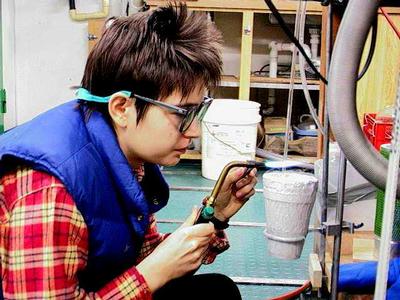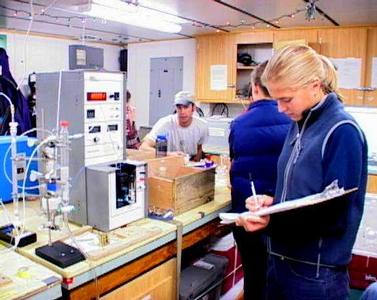20 March, 2001
Fire and Ice March 20 2001
-063 25 Lat / 52 11 long
No, not the perfume. It is just the name by which our lab is known. But let
us start from the beginning.
My name is Tzvetie. I am from Bulgaria, but now I go to school in the US -
Stanford University in California. I am a junior majoring in geology and my
main interest for right now is glacial geology. There are two other Stanford
students on this cruise - Melanie Hopkins and Lauren Rogers. We all work in
Professor Dunbar's biogeochemistry lab. We look at the changes in the
physical properties of seawater with depth. We use the CTD rosette to obtain
our samples from the bottom of the ocean. After the CTD comes back on board
Lauren, Melanie and I are responsible for sampling it and for processing the
samples.
We start by filtering the seawater through a filter, which lets water
through, but retains parcticulate organic matter (ex. phytoplankton). We will
take these samples with us back to Stanford. We will use a machine called a
Mass Spectrometer to determine the amounts of organic carbon and nitrogen.
After the water has warmed up to about 15 degrees C, Lauren runs it through
the Coulometer. The seawater reacts with phosphoric acid and the released
gas flows through the Coulometer, which measures the concentration of
dissolved inorganic carbon in the seawater.
But that is not all. We use the same water to take out the carbon that is
dissolved in the water and trap it in ampoules (a small airtight glass
tube). When we get back to Stanford we will test the gas in the ampoules for
the concentration of carbon thirteen (13C), an isotope of carbon. We make
these ampoules with fire and ice. First we let the sea water react with
phosphoric acid, releasing CO2, which is sent into a coil. The coil is
almost completely submersed in liquid nitrogen (aka dry ice). By freezing
the CO2 in the liquid nitrogen, we can separate it from the other gas
molecules, which freeze at a lower temperature. From there we transfer the
CO2 into a long glass tube. To speed up the transfer process, we reheat the
CO2 using a hair dryer. We slowly refreeze the gas in the bottom of the
glass tube and then very carefully melt the glass with a torch to create a
sealed ampoule. If we have done a good job there will be a small ring of
frozen gas at the bottom of the ampoule.
This procedure takes about twenty minutes. The Coulometer takes
approximately fifteen minutes and filtering generally takes between three
and four hours.
If we collect water at ten depths can you calculate how long it took us to
process it?





Contact the TEA in the field at
.
If you cannot connect through your browser, copy the
TEA's e-mail address in the "To:" line of
your favorite e-mail package.
|
